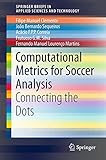Computational Metrics for Soccer Analysis [electronic resource] : Connecting the dots / by Filipe Manuel Clemente, João Bernardo Sequeiros, Acácio F.P.P. Correia, Frutuoso G. M Silva, Fernando Manuel Lourenço Martins.
By: Clemente, Filipe Manuel [author.] .
.
Contributor(s): Sequeiros, João Bernardo [author.] | Correia, Acácio F.P.P [author.]
| Correia, Acácio F.P.P [author.] | Silva, Frutuoso G. M [author.]
| Silva, Frutuoso G. M [author.] | Martins, Fernando Manuel Lourenço [author.]
| Martins, Fernando Manuel Lourenço [author.] | SpringerLink (Online service)
| SpringerLink (Online service) .
.
Material type:  BookSeries: SpringerBriefs in Applied Sciences and Technology: Publisher: Cham : Springer International Publishing : Imprint: Springer, 2018Edition: 1st ed. 2018.Description: XIII, 79 p. 27 illus., 21 illus. in color. online resource.Content type: text Media type: computer Carrier type: online resourceISBN: 9783319590295.Subject(s): Telecommunication
BookSeries: SpringerBriefs in Applied Sciences and Technology: Publisher: Cham : Springer International Publishing : Imprint: Springer, 2018Edition: 1st ed. 2018.Description: XIII, 79 p. 27 illus., 21 illus. in color. online resource.Content type: text Media type: computer Carrier type: online resourceISBN: 9783319590295.Subject(s): TelecommunicationBrief review about computational metrics used in team sports -- How to use the dots to analyze the behavior and the collective organization -- Individual metrics to characterize the player’s behavior: variability in the trajectories and external load -- Metrics to measure the center of the team -- Metrics to measure the dispersion of the players -- Metrics to tactical analysis -- The use of computational metrics in case studies: from small-sided games to official 11 vs. 11.
This book provides an account of the use of computational tactical metrics in improving sports analysis, in particular the use of Global Positioning System (GPS) data in soccer. As well as offering a practical perspective on collective behavioural analysis, it introduces the computational metrics available in the literature that allow readers to identify collective behaviour and patterns of play in team sports. These metrics only require the bio-dimensional geo-referencing information from GPS or video-tracking systems to provide qualitative and quantitative information about the tactical behaviour of players and the inter-relationships between teammates and their opponents. Exercises, experimental cases and algorithms enable readers to fully comprehend how to compute these metrics, as well as introducing them to the ultimate performance analysis tool, which is the basis to run them on. The script to compute the metrics is presented in Python. The book is a valuable resource for professional analysts as well students and researchers in the field of sports analysis wanting to optimise the use of GPS trackers in soccer. .


There are no comments for this item.